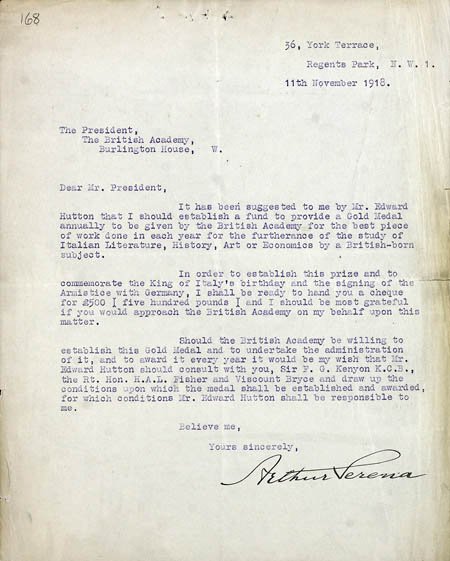This article is published in British Academy Review No. 34 (Autumn 2018).
The print version of this article can be downloaded as a PDF file.
In November 1918, Mr Arthur Serena wrote to the British Academy’s President, Sir Frederic Kenyon, offering £500 to fund a gold medal to be awarded annually by the Academy for the furtherance of Italian studies. Writing on the momentous 11th day of that month, Serena linked the establishment of the prize with the opportunity to commemorate both the King of Italy’s birthday and the signing of the Armistice with Germany that very morning.
Not a great deal is known about Arthur Serena. It is thought that he was born around 1852. His father, Leone Serena, was an exiled Venetian patriot who settled in London in the 1850s and became a successful shipping and insurance broker. His mother, Carla, was a Belgian journalist who spent much of her time abroad, writing articles and travel books. After university, Arthur Serena followed in his father’s footsteps and joined Galbraith, Pembroke & Co., where he became a senior partner. He never married. Following his death on 31 March 1922, his obituary in The Times noted that Serena was ‘very highly respected in the City, where his kindly manner, his generous instincts, and his wide interests made him many friends’.
As Serena approached his 70s, it seems that he suddenly became keen to use his wealth to establish some kind of legacy. Edward Hutton (1875-1969), a confirmed Italophile whose spiritual home was most definitely in Florence [note 1], later described what happened.
I founded the monthly Anglo-Italian Review and had written two articles for it on ‘The Italian Language’ when an old gentleman came to see me whom they had interested. This was Serena. He asked me over tea what I thought ought to be done to forward Italian studies in England. [note 2]
Hutton told Serena that neither Oxford nor Cambridge had a professorship of Italian. Serena immediately offered a substantial sum to rectify this – the generous benefaction was reported in The Times in October 1918. And he followed up with offers of money to establish chairs in Italian at the universities of Manchester and Birmingham.
As Serena’s letter to Kenyon reveals, Hutton also suggested that he might like to establish a fund for a medal to promote Italian studies. The British Academy readily accepted.

The first recipient of the Serena Medal, in 1920, was the historian G.M. Trevelyan, who had written three volumes depicting Garibaldi as a great hero – and who had also in the recent war commanded a British Red Cross ambulance unit on the Italian front (recalled in his Scenes from Italy’s War, published in 1919).
In 1924, Edward Hutton himself was awarded the medal.
There have been various changes to the award over the years. The stipulation in Serena’s letter that winners should be ‘British-born’ was quickly dropped: there have been many Italian nationals in the list of distinguished recipients. On a more practical level, in 1951 the minutes of the Academy’s Council note that, although the Serena medal was originally meant to be minted in gold, ‘the circumstances of time has necessitated a change to Bronze’.
In another evolution, to the list of eligible subjects specified in Serena’s letter – Italian literature, history, art and economics – have since been added philosophy and music. And this year, 100 years after Arthur Serena first approached the Academy with his proposal, the medal bearing his name has been awarded to Professor Roger Parker FBA, for his contribution to the study of 19th-century Italian opera.
Professor Parker writes: ‘Looking at the former recipients of this distinguished medal makes me feel both deeply honoured and deeply humbled. Many of those awarded the medal during its hundred-year history were giants in the field; to stand on their shoulders and attempt to peer forward will be immensely stimulating.’
Archival research and text by Karen Syrett and James Rivington.
Notes
1. Edward Hutton helped to establish the British Institute of Florence in 1917. In 1922, he delivered the British Academy Italian lecture on ‘Some aspects of the genius of Giovanni Boccaccio’. His villa in Florence was named Boccaccio.
2. Letter by Hutton to Professor Cecil Grayson, 1960, quoted in Uberto Limentani, ‘Leone and Arthur Serena and the Cambridge Chair of Italian, 1919-1934’, Modern Language Review, 92:4 (1997), at p. 879.